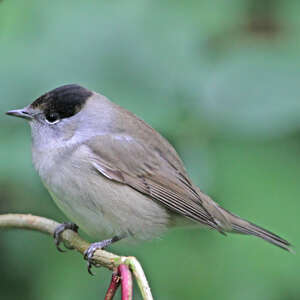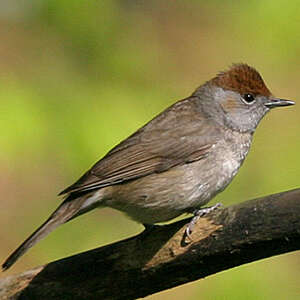Eurasian Blackcap
Sylvia atricapilla - Fauvette à tête noire
Identification
The Eurasian Blackcap is a medium-sized warbler (14 cm length), common and easily recognizable. Adults show sexual dimorphism. The adult male can be recognized by its black cap which clearly stands out against the light gray of the rest of the head. The female has a reddish-chestnut cap that is quite vivid but less conspicuous. Both of them tend to erect the feathers of their cap, which increases visibility. Overall, both sexes have gray plumage, but the gray is more marked and pure in males, particularly in the head and neck. With males, the mantle, wings and tail are subtly brown-olive, but this varies between individuals, their geographic location, the time of year and the state of plumage. The underside is whitish with some gray, mostly on the sides. The dark eye is surrounded by a whitish eyering. The bill is black and the legs are gray. The female differs from the male in her cap color, as mentioned earlier, but also with a less gray plumage, more clearly brownish-olive above and gray-beige to pale chamois underneath. The juvenile, whichever sex, looks like the female. But its plumage is even less gray, more brown, more uniform, and above all, its cap is a dull almost brown chestnut color. Its bill is basally whitened. Sex can only be determined after the post-juvenile molt, when the young male can be distinguished by its black feathers appearing in the red cap. There are 5 subspecies that only differ in slight size and color differences. The male of the subspecies heineken can be melanistic and have a black head, neck and upper chest.
Subspecific information 5 subspecies
- Sylvia atricapilla atricapilla (w Europe to sw Siberia and n Kazakhstan)
- Sylvia atricapilla gularis (Cape Verde and Azores Is.)
- Sylvia atricapilla heineken (w and s Iberian Pen, Madeira and Canary Is. and nw Africa)
- Sylvia atricapilla pauluccii (e Spain to c and s Italy, nc Africa)
- Sylvia atricapilla dammholzi (e Turkey to n Iran)
Foreign names
- Fauvette à tête noire,
- Curruca capirotada,
- toutinegra-de-barrete,
- Mönchsgrasmücke,
- barátposzáta,
- Zwartkop,
- Capinera,
- svarthätta,
- Munk,
- penica čiernohlavá,
- pěnice černohlavá,
- Munk,
- mustapääkerttu,
- Swartkroonsanger,
- tallarol de casquet,
- Hettusöngvari,
- kapturka,
- melngalvas ķauķis,
- črnoglavka,
- Славка-черноголовка,
- ズグロムシクイ,
- 黑顶林莺,
- svarthätta,
- 黑頂林鶯,
Voice song and call
The usual contact call of the Eurasian Blackcap is a sharp, crisp tac, somewhat like the sound produced by two stones being clinked together. It is emitted in series, with the rhythm accelerating in danger or neighborly conflict. Other calls exist, such as an ist, sometimes doubled to an e ist, quite frequent and slightly ascending. Its very sonorous, fluty song is striking. It is highly rhythmic, with voices bursting out and a rapid succession of stereotyped syllables that make it different from the more regular, calmer and basically more melodious Garden Warbler song. The song is often preceded by a typically sylvid grating prelude that can last a long time before it passes to its usual register. This is frequently the case when the territory is not yet well established, or when there is conflict between males. The song is sometimes imitative, but rarely, as it is done by certain more talented males. The imitations can be so perfect as to fool us. Personally, I have already heard remarkable imitations of the nightingale and the reed warbler. If I had not seen the warbler singing, I would have been fooled.
Habitat
The Eurasian Blackcap inhabits quite open, well-stocked habitats with trees, shrubs and bushes. It is not really a forest bird as it does not occupy mature, dense canopies.
Behaviour character trait
The Eurasian Blackcap is a common bird, not particularly shy, easy to identify in the spring by its song but less easy to observe.
In western Europe, birds in the south of their breeding range are sedentary while northern birds are migratory. And the more latitude and harsher climates. There are sedentary birds in the south of France while those in the far north-east leave in winter. But current climate change is changing the picture. Mild winters allow an increasing number of blackcaps to winter further north than before. The species is not gregarious, it is a family trait. It feeds alone, migrates alone and at night. Nevertheless, when food is abundant, for example when elder bushes are covered with juicy bunches of berries in the summer, many blackcaps can be seen feeding together but with no real interactions between them. In winter, they do not visit bird feeders, as they are not interested in the seeds. On the other hand, mistletoe and ivy berries are essential for their survival at this season.Dietfeeding habits
The diet is mixed. During the breeding season, the Eurasian Blackcap is almost exclusively insectivorous.
Its range is very wide and includes many species of flying insects, but also arachnids, crustaceans, millipedes, small molluscs, etc. The young are fed exclusively on invertebrates. The prey are mainly hunted in vegetation, much less often on the ground. After reproduction, when the vegetation is full-grown, it becomes distinctly frugivorous and will remain so for the entire bad season. Here again, the range is wide. It consumes abundantly the tiny berries of woody plants (elders, brambles, dogwood, ivy, mistletoe, raisins...) but also bigger fruits. For example, it loves overripe figs. It can use this resource at the beginning of its breeding season, when the insect population is not yet abundant. Then it is the ivy and the mistletoe that are exploited.Reproduction nesting
The breeding season runs from April to August on the European continent. It is even shorter if the climatic conditions are harsh. Thus, in the northern part of its range or at higher altitudes, Eurasian Blackcap is only able to do one clutch, whereas in more favourable temperate or Mediterranean climates, two successive clutches are possible. On Cape Verde, the breeding season is winter (August to November and January to March). The species knows how to adapt to special circumstances. The nest is built by the couple, usually starting from an outline made by the male, in a low and dense deciduous shrub, often a bramble, Rubus being common in its environment, usually at around one metre from the ground.
It is made up of interwoven dry branches and herbs, often held together with spider webs. The inside is lined with finer elements, vegetal fibres, rootlets and animal hair on occasions. It is quite small and requires two to five days of work. The female usually lays four to five eggs (three to six) but this number decreases with latitude, altitude or the advance of the season (second clutch being less abundant). The egg is heavily spotted with brown. Incubation, carried out by both adults, takes around twelve days. This is followed by a stay of the pullus at the nest of ten to fifteen days. Once the young one have fledged, they will remain under the parents care for two to three weeks, although they are able to feed themselves at fifteen days. With a 40 to 60% success rate in the breeding, the reproductive success is quite low. The two main causes of failure are predation and abandonment. Population recovery is due to survival rates.Geographic range
The Eurasian Blackcap is a mainly European species. It can be found from the Atlantic to the Ural Mountains. To the north, it occupies the southern part of Fenno-Scandia. To the south, its nesting area extends to the Maghreb, Asia Minor (Turkey), the Near East (Lebanon, Israel) and northern Iran. Subspecies occupy the Macaronesian islands from the Azores to Cape Verde. The wintering area covers the south-west part of the nesting area, mainly around the western Mediterranean, much less to the east. It extends far to the south in Africa. To the west, the species winters from southern Morocco to Nigeria. To the east, it follows the Nile valley with an important wintering in Ethiopia, and extends to Malawi and Zambia, but with limited numbers. On the large eastern Mediterranean islands (Cyprus, Crete), it is only a winter visitor.
Threats - protection
IUCN conservation status
concern
in the Wild
threatened
evaluated
This species is not threatened. It is common to very common throughout most of its range. In favourable habitats, the density can exceed 1 couple per hectare, or even approach 2 couples per hectare. An easily implemented measure of protection is to forbid any clearing or thinning work during the breeding season.
Sources of information
- IOC World Bird List (v15.1), Gill, F and D Donsker (Eds). 2025-12-07.
- Les passereaux d'Europe, tome 2, P. Géroudet, M. Cuisin
- Avibase, Lepage Denis
- HBW Alive,
- xeno-canto, Sharing bird sounds from around the world,
Other sources of interest
 Specification sheet created on
07/07/2023 by Jean François
Specification sheet created on
07/07/2023 by Jean FrançoisTranslation by AI Oiseaux.net
© 1996-2026 Oiseaux.net
- Accipitriformes
- Aegotheliformes
- Anseriformes
- Apodiformes
- Apterygiformes
- Bucerotiformes
- Caprimulgiformes
- Cariamiformes
- Casuariiformes
- Charadriiformes
- Ciconiiformes
- Coliiformes
- Columbiformes
- Coraciiformes
- Cuculiformes
- Eurypygiformes
- Falconiformes
- Galliformes
- Gaviiformes
- Gruiformes
- Leptosomiformes
- Mesitornithiformes
- Musophagiformes
- Nyctibiiformes
- Opisthocomiformes
- Otidiformes
- Passeriformes
- Pelecaniformes
- Phaethontiformes
- Phoenicopteriformes
- Piciformes
- Podargiformes
- Podicipediformes
- Procellariiformes
- Psittaciformes
- Pterocliformes
- Rheiformes
- Sphenisciformes
- Steatornithiformes
- Strigiformes
- Struthioniformes
- Suliformes
- Tinamiformes
- Trogoniformes

































